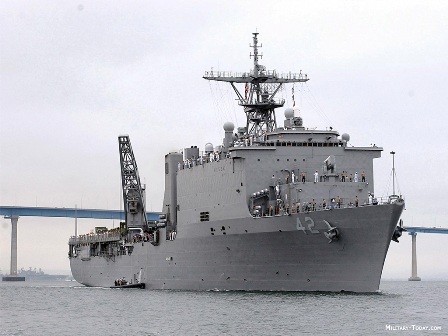Whidbey Island-class (LSD-41)
Summary
| Origin country | 🇺🇸 United States |
| Category | Amphibious vessel |
| Subtype | Landing craft transport |
| Manufacturer | Lockheed Shipbuilding and Construction Company |
| Year commissioned | 1985 |
| Approx. unit cost | $250 million |
| Units |
LSD-41 Whidbey Island LSD-42 USS Germantown LSD-43 Fort McHenry LSD-44 USS Gunston Hall LSD-45 USS Comstock LSD-46 USS Tortuga LSD-47 USS Rushmore LSD-48 USS Ashland |
| Current operators | 🇺🇸 United States |
Description
The Amphibious Ship Dock (LSD) 41 Whidbey Island class is a versatile and powerful class of amphibious assault ships employed by the United States Navy. These ships serve as a critical component of the Navy's amphibious warfare capability, providing the ability to transport and deploy Marines, their equipment, and various types of vehicles and aircraft.
The Whidbey Island class ships are designed to perform well in both peacetime and combat operations. With a displacement of approximately 16,000 tons, they have a length of 609 feet, a width of 84 feet, and a draft of 21 feet. This class incorporates a well deck, aircraft capabilities, and accommodations for a full battalion of Marines, ensuring a truly multi-functional ship that can support a wide range of missions.
One noteworthy feature of the Whidbey Island class is its well deck, located towards the stern. This well deck enables the loading, launching, and recovery of various types of amphibious assault vehicles, landing craft, and air-cushioned landing craft. This capability greatly enhances the ship's effectiveness in conducting operations such as humanitarian assistance, disaster relief, and amphibious assaults.
Additionally, these ships possess a flight deck and hangar, allowing them to support a variety of aircraft including helicopters, tiltrotor aircraft, and short takeoff and vertical landing (STOVL) aircraft. By integrating air assets, the Whidbey Island class can enhance the operational flexibility and effectiveness of embarked Marine forces, maximizing their capabilities during a mission.
In terms of capabilities, the Whidbey Island class can support a full complement of embarked Marines, typically a Marine Expeditionary Unit (MEU) or a Marine Expeditionary Brigade (MEB). With its well deck, flight deck, and ample accommodations, these ships ensure that Marines and their equipment can be transported, sustained, and rapidly deployed for various military operations around the world.
The Whidbey Island class of amphibious ships plays a crucial role in projecting power and supporting military operations. With their unique combination of strategic mobility, swift response capability, and versatile design, these ships contribute significantly to the expeditionary and amphibious warfare capabilities of the United States Navy.
Technical specifications
| Displacement | 15745 tons |
| Range | 8000 km at 18 knots |
| Crew | 804 members |
| Width | 26.0 m (85.3 ft) |
| Length | 186.0 m (610.2 ft) |
| Propulsion | 4 Colt-Pielstick 16 PC2-5 V400 diesels with a power of 41,600 hp total - 2 propellers |
| Thrust | 9200 hp |
| Armament | 2 RAM Mk.31 + 2 CIWS Mk.15 Phalanx + 2 Mk.38 25mm guns + 8 12.7mm machine guns |
| Maximum speed | 20 knots |
